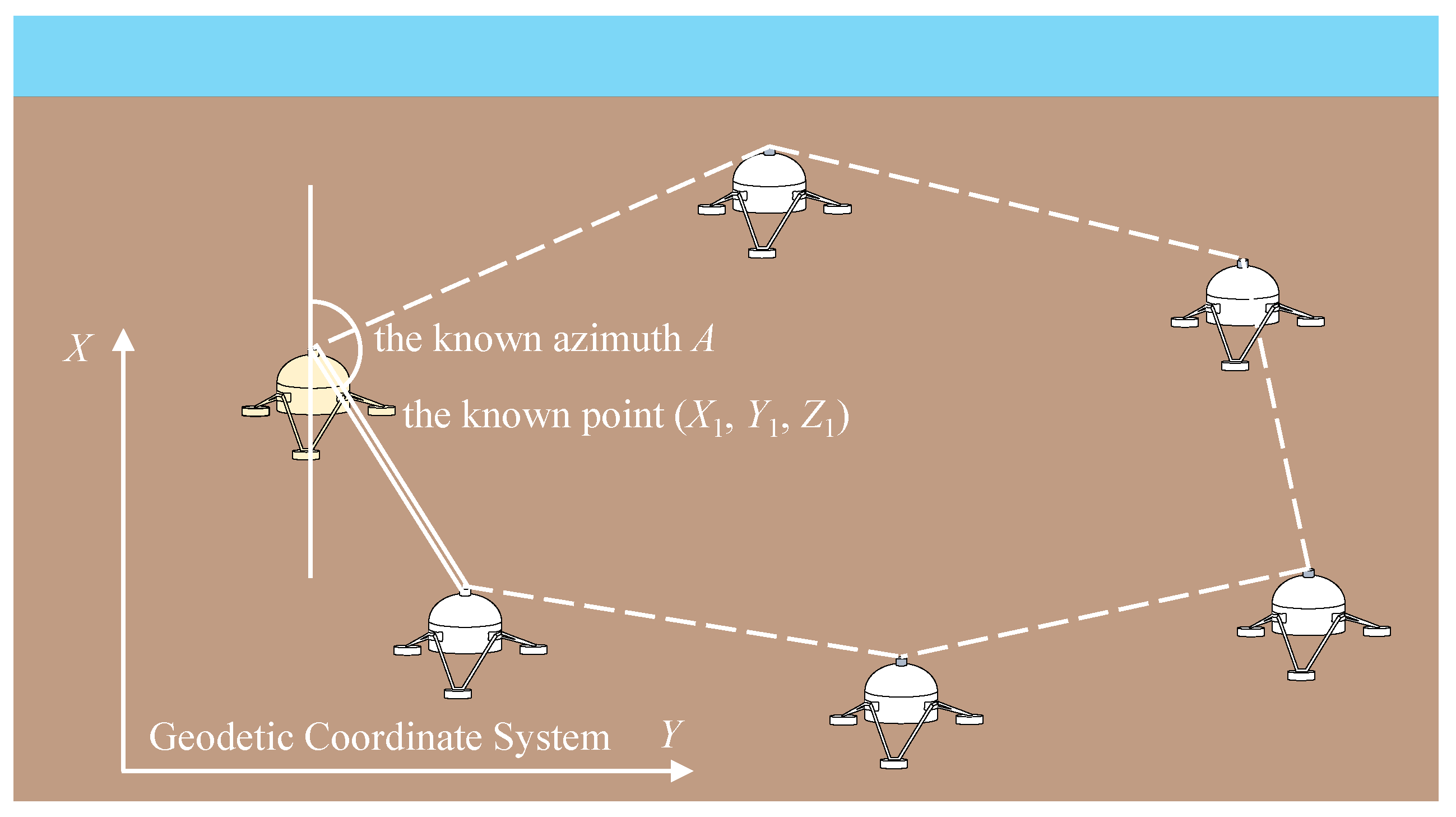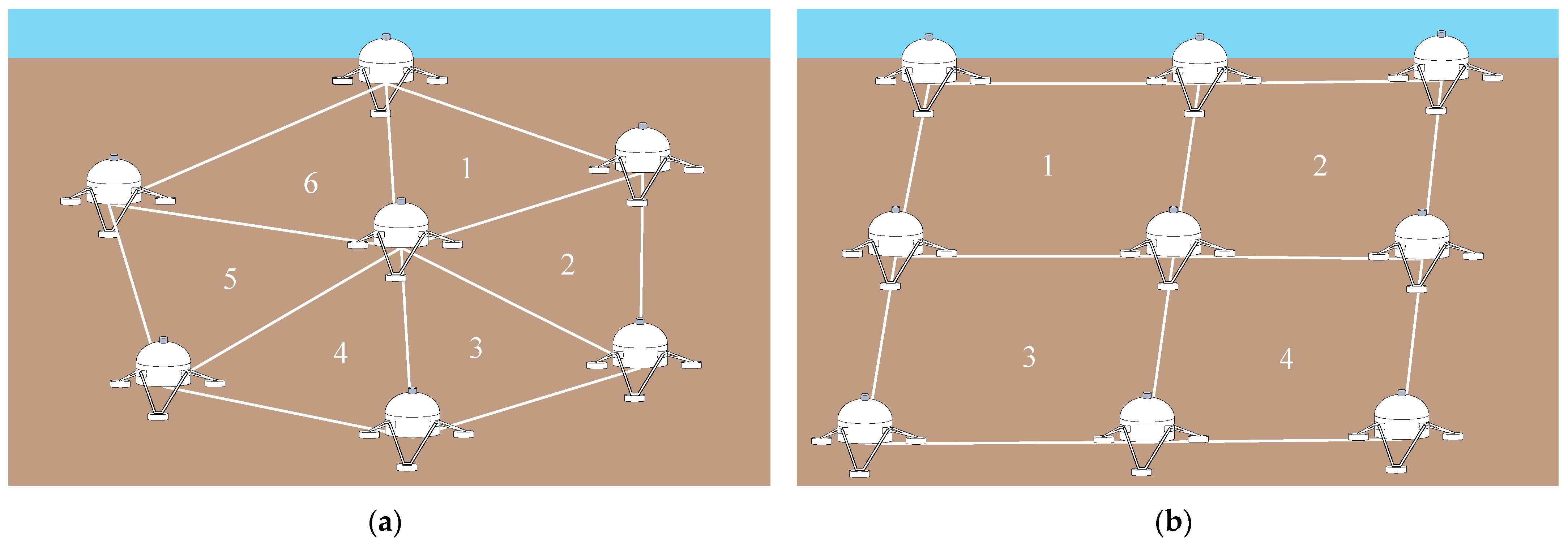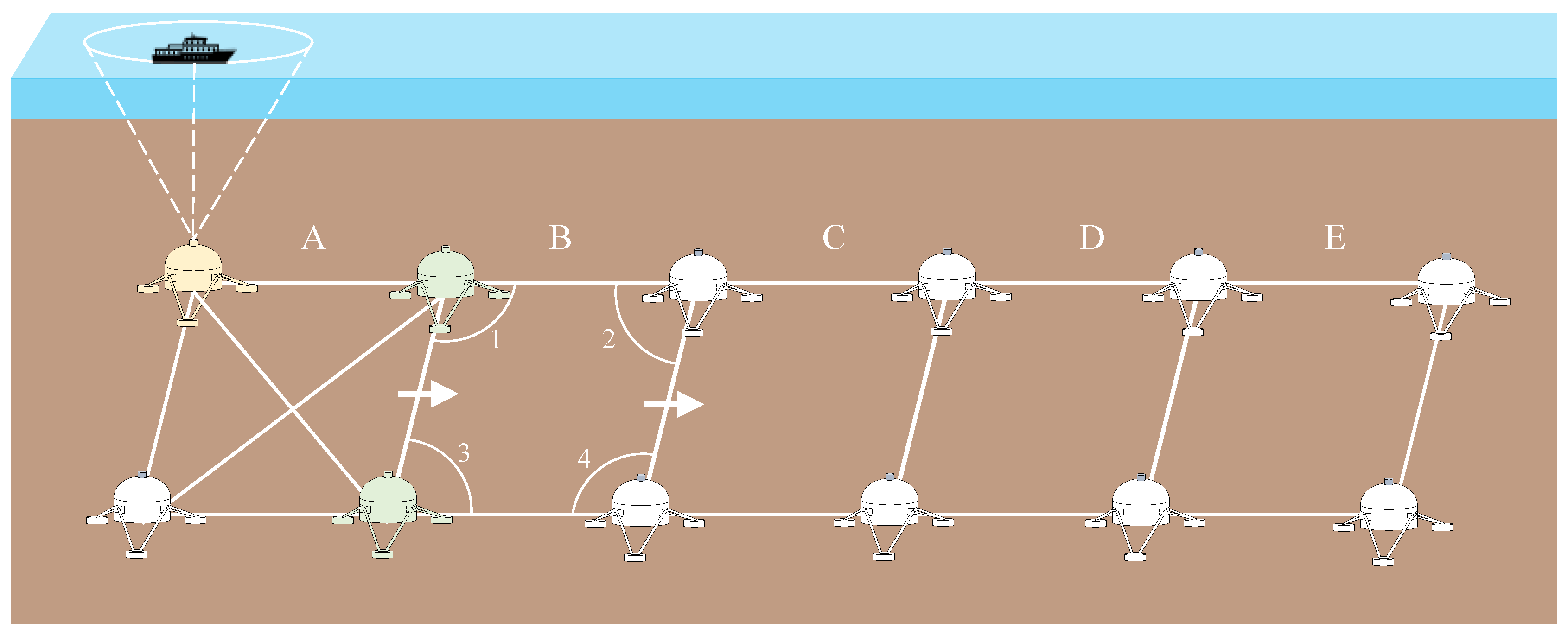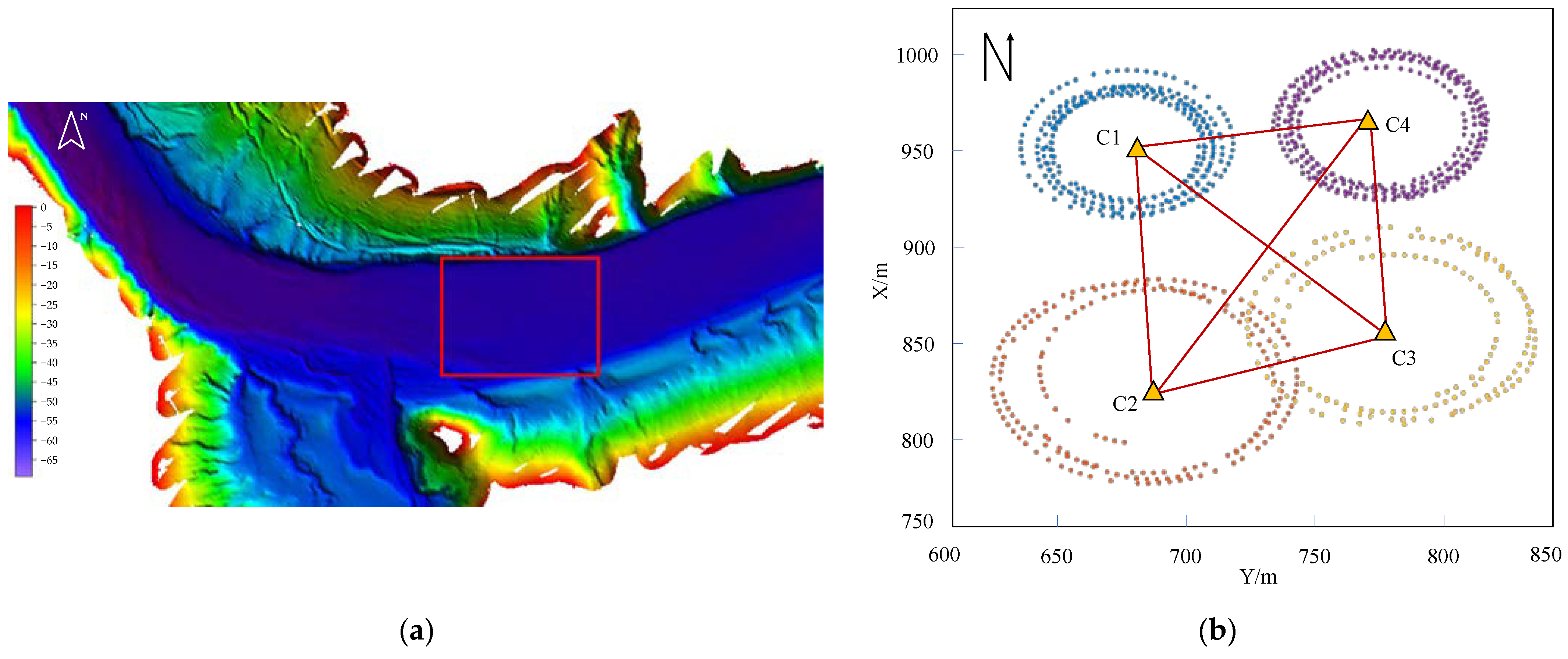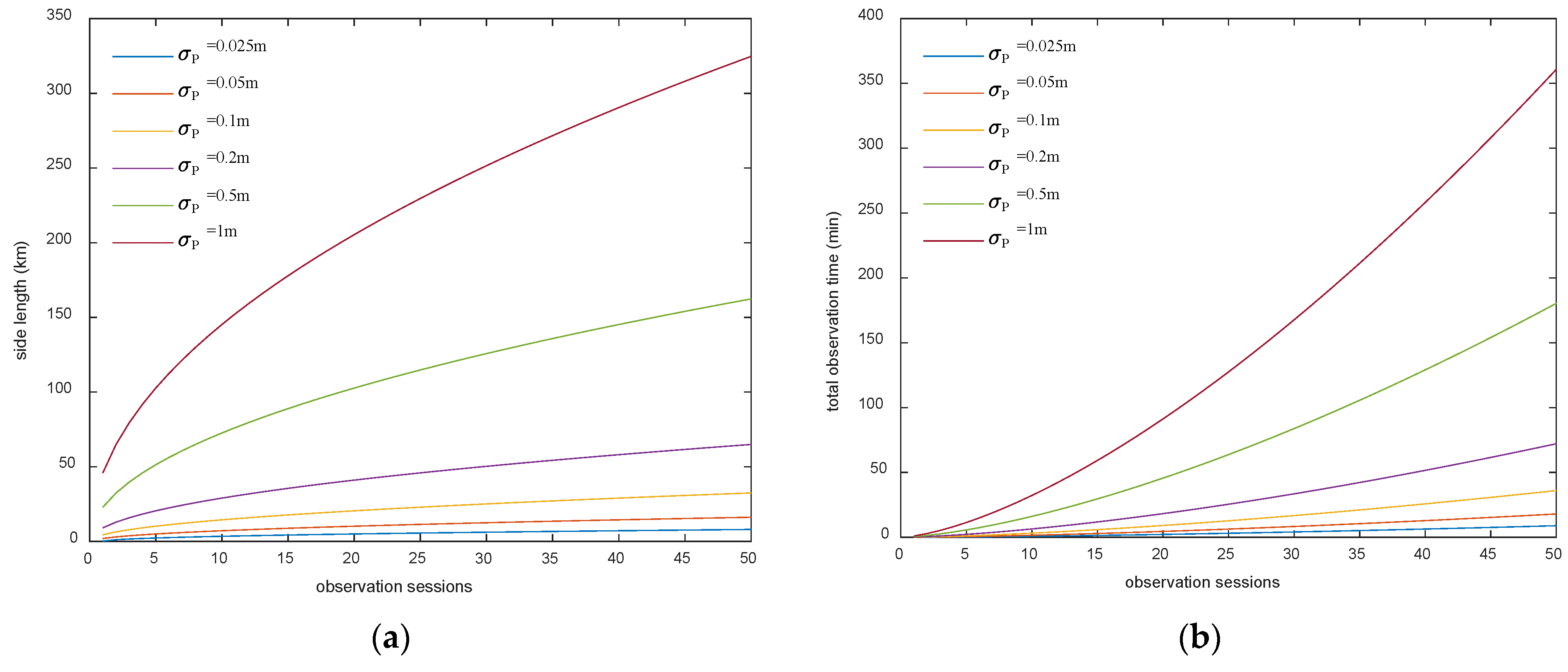1. Introduction
The marine geodetic network is the reference frame for all marine activities. It consists of buoy datum stations on the ocean surface, mobile datum stations in the water, and the seafloor geodetic network [
1]. The seafloor geodetic network is the most important component of the marine geodetic network owing to its good stability and high positioning accuracy, which plays a very important role in ocean engineering [
2]. In recent years, coastal states have paid more and more attention to the construction of seafloor geodetic networks. Some countries or organizations, such as the United States, Japan, China, and the European Union, have established seafloor geodetic networks in some waters, which mainly serve marine environment monitoring and seafloor crustal deformation observation [
3,
4,
5,
6]. The seafloor geodetic network for observing seafloor crustal deformation has three main forms, including the direct-path acoustic network, the indirect-path acoustic network, and the Global Navigation Satellite System-Acoustic (GNSS-A) network [
7]. In the direct-path acoustic network (
Figure 1a), two precision acoustic beacons are placed on faults, and repeated interrogations over months to years measure the fault displacement. To overcome the influence of the pressure on the propagation of acoustic waves in the direct-path network, the indirect-path network was invented (
Figure 1b), in which at least three seafloor acoustic beacons are deployed, and a floating unit with a depth sensor is added several hundred meters above the beacons [
8]. To overcome the effect of seawater stratification on acoustic ranging, researchers have further improved the arrangement of acoustic beacons on the seafloor; three or more beacons are evenly spaced around the perimeter of a circle with a radius of the water depth, which is called the GNSS-A network (
Figure 1c). In the GNSS-A network, the positioning of the seafloor acoustic beacon is realized by combining the coordinates of the onboard transducer provided by the GNSS system with the geometric distance between the onboard transducer and the seafloor beacon [
9,
10,
11].
With the increase in marine activities, the application scope of the seafloor geodetic network has been expanded, such as in underwater positioning, navigation, and timing (PNT) for survey ships on the surface and underwater vehicles. In 2015, the American Defense Advanced Research Projects Agency (DARPA) announced the development of the Positioning System for Deep Ocean Navigation (POSYDON), which aims to provide omnipresent, robust positioning for ships and submarines across ocean basins by establishing the “GNSS-like” underwater navigation system, that is, the long baseline hydroacoustic positioning network (called the seafloor PNT network for short) using low-frequency sonar [
12]. In 2016, China launched the national key research and development project named Marine Geodetic Datum and Marine Navigation and Positioning Technology, which aims to construct the large-scale seafloor PNT network [
13,
14]. The idea of underwater PNT is as shown in
Figure 1d. The network is achieved by first deploying sonar beacons (similar to satellites) on the seabed to form a seafloor geodetic network, and determining the coordinates of all seafloor sonar beacons. Vehicles can then obtain their coordinates by range intersection positioning using acoustic signals (similar to satellite signals) from the seabed sonar beacons with known coordinates. However, the limited coverage area and specialized purpose make it difficult to serve large-scale underwater PNT for the direct-path acoustic network, indirect-path acoustic network, and GNSS-A network. Therefore, how to construct the underwater PNT network is a new question to discuss.
Similar to the terrestrial geodetic network, a large-scale seafloor PNT network is generally composed of several unit networks, such as the white triangles and squares in
Figure 1d. Therefore, it is necessary to formulate a scheme for the optimization of the whole network before deploying sonar beacons from the cost, reliability, and precision views. Up to now, many scholars have carried out research on the optimization of the geodetic network. In 1974, Grafarend proposed four orders for designing the geodesic network, including designing the best datum and coordinate system of the network, designing the best configuration of the network, designing the suitable precision of the observations and types of observations, and designing the expansion or densification of the network [
15]. Based on the four orders, in 1985, Koch mentioned the optimum configuration problem of the geodetic network first and used the quadratic programming and linear complementary problem to obtain the position changes or configuration of the network in an optimal way [
16]. In 2007, Eshagh and Kiamehr put forward a strategy for the optimum design of the geodetic network using optimization models from a mathematical point of view [
17]. In 2009, Bagherbandi et al. obtained the optimum configuration and observation weights in geodetic networks considering the postulated reliability and precision requirements [
18]. In 2017, Horemuž and Jansson investigated the optimum horizontal location of the total station in a simple network in which a total station measures several control points in the process of being established [
19]. In the following year, Alizadeh et al. investigated the optimal vertical placement of the total station with the variances criterion that related to the sum of total station coordinates and orientations [
20]. The studies mentioned above mainly focused on the terrestrial geodetic network, while only a few scholars have studied the optimization of the seafloor PNT network. In 2020, Yang et al. gave the basic principles of the seafloor PNT network design. They believed that three sonar beacons can determine the 3D position of the underwater vehicle, so a equilateral triangle should be the optimal configuration of the unit network in the underwater PNT network. If the redundancy is taken into consideration, then at least four necessary reference points and one redundant reference point constitute the simplest network type, that is, an equilateral pentagon should be the optimal configuration of the unit network in the underwater PNT network [
21]. However, the conclusion comes from experience and has not been proven by strict theory, and at present there is no strict optimization theory and design principle of the seafloor PNT network.
With the rapid development of GNSS positioning technology, the impact of a terrestrial geodetic networks’ configuration on positioning accuracy has become less prominent [
22]. Moreover, because the electromagnetic wave is easily attenuated in water while the acoustic wave can travel great distances, the underwater positioning mode mainly depends on the acoustic wave [
23]. Therefore, it is not applicable to directly transplant the optimization principle of the terrestrial geodetic network into the seafloor PNT network. Given the present situation, this paper studies the optimal design of the seafloor PNT network on the basis of Grafarend’s four orders for designing the geodesic network. The research tasks are as follows. Firstly, the positioning method of seabed control points in the underwater PNT network will be studied, based on which there are two main questions that need to be explored. One is the best configuration of the unit network, that is, how long should the side length of the unit network be and how many observation sessions should be carried out during the observation period under different positioning precisions. The other is how to ensure the positioning accuracy of seafloor control points during the expansion of the underwater PNT network.
The remainder of this paper is organized as follows. In
Section 2, the measurement method and adjustment model of the seafloor PNT network are presented. In
Section 3, the best configuration of the unit network in the seafloor PNT network is introduced. In
Section 4, a chain coordinate transfer strategy is proposed to determine the distribution of the known control points in the expansion of the seafloor PNT network.
Section 5 presents an experiment to prove the applicability of the proposed method in
Section 2 and shows the layout schemes of seafloor PNT networks with centimeter, decimeter, and meter level precision on the basis of
Section 3 and
Section 4. Finally, conclusions are drawn in
Section 6.
2. The Combined Measurement Method for the Seafloor PNT Network
It is necessary to first determine the coordinates of all control points in the seafloor PNT network according to the principles of underwater PNT. At present, the most commonly used method to determine the coordinates of underwater control points is circle-sailing positioning. The principle of circle-sailing positioning is as follows. The survey ship follows a circular trajectory, centering on the control point. During the sailing, the coordinates of the onboard transducer are provided by GNSS in real time, and the distance between the transducer and the acoustic beacon installed on the seafloor control point is measured by sound waves. Finally, the position of the control point is determined by the range intersection model constructed by combining the coordinates of the onboard transducer and the acoustic ranging results [
24]. This method is highly accurate but time-consuming and laborious. Self-calibrating beacons simplify the task by reducing the surveying task to only one or a few beacons, with the others determining their own positions relative to the beacons that have been carried out by circle-sailing [
25]. Due to the limited range capability of acoustic beacons, usually about 10 km [
26], the relative positioning between beacons is only carried out within the unit network in the seafloor PNT network.
Therefore, the combined measurement method is proposed. As shown in
Figure 2, there are two parts in the combined measurement method. The first part is the absolute positioning of several certain control points by circle-sailing positioning. The second part is the relative positioning among all control points, that is, the relative coordinates among seafloor control points are determined by constructing the free network adjustment model using the mutual acoustic ranging results provided by the acoustic beacons installed on them. The two parts can be carried out simultaneously, and the coordinates of all control points can be obtained by combining the results of the two.
2.1. The Adjustment Model of the Absolute Positioning
The model of the absolute positioning in a unit network is shown in Equation (1).
where
is the geometric distance between the onboard transducer and the acoustic beacons installed on the seafloor control point
P at the
ith observation time, which is determined by acoustic ray tracing based on the one-way travel time between the two;
and
are the coordinates of the transducer at the
ith observation time and the control point
P, respectively;
ɛi is the observation error.
Linearize Equation (1) to obtain the error equation:
where
and
is the prior coordinates of the control point
P. A series of observation equations with the form of Equation (2) can be represented by the matrix notation, as shown in Equation (3).
where
,
,
, and
; the symbol “[
Ai]” represents the
ith row of the matirx
A, the superscript “
T” represents the transpose of the matrix, and the subscript “
a” represents the absolute positioning.
On the basis of the least-squares criterion, the coordinate corrections
and the final coordinates
XP of the control point can be acquired through Equation (4).
where
Wa is the weight matrix of all observations; generally it is a diagonal matrix, and
.
The precision of the absolute positioning is given in Equation (5).
where
is the variance matrix of the control point coordinates,
is the standard deviation, and
is the covariance matrix of the control point coordinates.
When the absolute positioning is completed, the coordinates of the control point, which has been carried out by the circle-sailing positioning, can be known. Therefore, in this paper, the control point is called “the known point”.
2.2. The 2D Adjustment Model under Depth Constraint in the Relative Positioning
Generally, there is a pressure sensor installed on the seafloor control point that can provide the high-precision depth from the sea surface to the control point. The elevation of the control point can then be obtained by subtracting the depth from the elevation of the sea surface. In this case, the 3D adjustment model in the relative positioning of a unit network can be transformed into a 2D adjustment model. As shown in
Figure 3, the geometric distance,
Spq, between control points p and q can be obtained by in-layer constant gradient acoustic ray tracing using the acoustic observed value, then the horizontal distance,
Dpq, between the two control points can be calculated based on Equation (6) by combining
Spq with the elevation difference, Δ
Zpq [
27].
If there are
m control points in the unit network, then the number of measured horizontal distance observations,
n, is equal to
m(
m − 1)/2. Supposing that the horizontal coordinates of two control points,
p and
q, are
and
, respectively, then the horizontal distance observation,
Dpq, between
p and
q can be expressed by Equation (7).
where
ɛpq is the observation error. Equation (7) is linearized to obtain the error equation:
where
and
;
are the prior coordinates of control points
p and
q, respectively.
The error equations of
n horizontal distance observations can be written into matrix form, as shown in Equation (9).
where the subscript “
r” represents the relative positioning.
Vr,
Br,
xr, and
Lr are given in Equation (10).
As shown in
Figure 4, only one known control point and one known azimuth are provided, and the question is, can the 2D unit network be fixed in a geodetic coordinate system? Because there are no known conditions during the relative positioning, design matrix
B is rank-deficient and the number of rank deficiency,
d, is equal to 3.
The rank defect network adjustment under the barycentric datum is adopted to solve Equation (10), and the additional datum constraint condition is given in Equation (11).
where
S is the base condition matrix and meets the following conditions:
,
,
;
Wx is the base weight matrix and is an identity matrix. The specific expression of
ST is shown in Equation (12).
Combining Equations (9) and (11), the coordinate corrections,
, and the final coordinates,
X, of the control points can be obtained by Equation (13) under the adjustment criterion of
.
The precision of the relative positioning is given in Equation (14).
where
is the variance matrix of the control point coordinates,
is the standard deviation,
is the covariance matrix of the control point coordinates, and GDOP is the geometric dilution of precision of the control point.
The relative coordinates between the known point and the other control points can be acquired after the model of the relative positioning is solved, and then the coordinates of all control points can be calculated by combining the coordinates of the known point and the relative coordinates.
3. The Best Configuration of the Unit Network in the Seafloor PNT Network
In the seafloor PNT network, the longer the unit network side length, the lower the control point density and the lower the layout cost. In the relative positioning, the more acoustic ranging observation sessions there are, the higher the ranging accuracy. In order to balance the layout cost and observation efficiency, it is necessary to study the relationship between the side length of the unit network and the number of observation sessions.
It can be proved that the coverage area of the regular polygon is the largest in the same circumcircle. Therefore, in order to achieve the maximum coverage under the same number of control points, the unit network of the seafloor PNT network is generally arranged as a regular polygon. As shown in
Figure 5, in order to achieve seamless full coverage of the water area, the unit network is designed as an equilateral triangle (GDOP = 0.808 when the side length of the unit network is 1 km) or square (GDOP = 0.802) in most cases. Additionally, when the navigation and positioning accuracy requirements are undemanding, the unit network may be designed as a regular hexagon (GDOP = 0.837).
As mentioned in
Section 2, the ranging capability of the acoustic beacons is limited. If the upper limit,
R, of the range of the acoustic beacon is known, the maximum side length,
Lmax, of the equilateral triangle and the square unit network are equal to
R and
, respectively. In the following, the functional relationship between the side length of the unit network and the navigation and positioning accuracy of the control points will be derived.
As shown in
Figure 6, there are two known control point in an equilateral triangle unit network, and the distance,
S0, and the azimuth,
α0, between points
A and
B can be acquired based on the geometric relations. The coordinates (
XP,
YP) of the unknown control point
P can then be obtained by Equation (15).
where
S is the distance between point
P and
A; α is the azimuth between the two points and it meet the condition in Equation (16).
Based on the law of cosines, Equation (17) can be given in the triangle ΔABP.
where
S′ is the distance between point
P and
B.
S and
S′ can be measured by acoustic ranging, and their ranging accuracy are known. By differentiating both sides of Equation (17), we can acquire:
where
ρ is the conversion parameter between angle and radian and
ρ = 180°/
π. Because
S0 is known, which means
dS0 is equal to 0, Equation (18) can be simplified as Equation (19).
By combining Equations (16) and (19), the following equation can be obtained:
where
.
In the equilateral triangle unit network, the ranging accuracy of
S is equal to that of
S′. Supposing the ranging accuracy of
S and
S′ is
σS, then the covariance matrix between
S and
α can be depicted as Equation (21) by the variance–covariance propagation law.
Equation (15) can be differentiated and the result written into matrix form, as shown in Equation (22).
Then, according to the variance–covariance propagation law, Equation (23) can be obtained.
Based on Equation (23), the coordinate accuracy,
σP, of point
P is given by Equation (24).
By substituting
x1 and
x2 into Equation (24) and considering the geometric conditions
S =
S′ =
S0 and ∠
B = ∠
P = 60° in the equilateral triangle unit network, Equation (25) can be obtained.
According to the same principles, the relation between ranging accuracy,
σS, and the coordinate accuracy,
σP, of the unknown point in the square unit network can also be derived, as shown in Equation (26).
Because the distance,
S, between two control points is determined by the sound velocity,
c, and the one-way propagation time,
t, of the acoustic wave, we can acquire Equation (27).
Suppose that the measurement accuracy of sound velocity and time are
σc and
σt, respectively, then, based on the law of error propagation, it can be known that the ranging accuracy,
σS, meets the condition in Equation (28).
Substituting Equation (28) into Equations (25) and (26), the function of the side length,
S, and the coordinate accuracy of control points,
σP, in one observation period can be obtained, as shown in Equation (29), where the subscripts “3” and “4” represent the number of edges in a unit network.
The limiting conditions for the above formula are
and
. If there are
N observation sessions, that is, each side in the unit network has been observed for
N times, the ranging accuracy,
σS, satisfies Equation (30).
The relation between the side length and the coordinate accuracy of control points in
N observation sessions can then be given by Equation (31).
To sum up, in the case that the positioning accuracy of the control points in the seafloor PNT network and the number of observation sessions are given, the side length of the unit network can be determined based on Equation (31). Furthermore, if the positioning precision and the side length of the unit network have been given, the optimal number of observation sessions can be determined.
4. The Distribution of Known Control Points in the Seafloor PNT Network
Due to the large area of the seafloor PNT network, it is time-consuming and high cost to carry out circle-sailing positioning in each unit network in the absolute positioning. To solve this problem, the chain coordinate transfer strategy is proposed, whose principle is as follows.
As shown in
Figure 7: Firstly, carry out the absolute positioning and the relative positioning in the initial unit network A to determine the coordinates of all control points in it. Then, utilize the results of acoustic ranging in the unit network B adjacent to A to obtain the angle (Angles 1, 2, 3, and 4) between each edge in B. Finally, determine the coordinates of unknown points in B using the coordinates of common points between A and B, the acoustic ranging results, and the computed angles in B. Once the coordinates of the control points in B are determined, it can be regarded as “the initial unit network” relative to the unit network C. The coordinates of the control points in other unit networks (C, D, E, etc.) can then be determined by repeating the process.
During the coordinate transfer in the seafloor PNT network, the positioning error will increase with the increase of the number of unit networks. Circle-sailing positioning should be carried out at the control point whose positioning accuracy is less than the lower limit of accuracy (called “the weakest point” for short) to calibrate its coordinates. Therefore, determining the position of the weakest point is inevitable.
As shown in
Figure 8, suppose that the diagonal length between the starting known point
P1 and the weakest point
Pn is
L. Due to the error of acoustic ranging, the computed position of
Pn is offset to
Pn″, the offset in distance is
f (
Pn Pn″), and the offset in azimuth is
dA. The offset
f can be decomposed into the longitudinal offset
t and the transverse offset
u, which are equal to
PnPn′ and
Pn′
Pn″, respectively. The offsets
f,
t, and
u meet the condition in Equation (32).
Suppose that the positioning accuracy of
Pn is
σP and the mean square error of
t,
u, and
dA are
σt,
σu, and
σA(
L), respectively, the relation among them is given by Equation (33).
If the number of unit networks shown in
Figure 8 is odd, namely there are (2
n − 1) unit networks with side length
S in the seafloor PNT network, and the observed distance between the control points located on
L in the
ith unit network is
Si, then Equation (34) can be obtained.
Suppose that the length of the starting edge is
S0, then, according to the geometric relations in the equilateral triangle unit network, we can obtain Equation (35).
where
θ1,
θ2, …,
θ6n−4 are the computed angles in the unit networks, which can be calculated based on the law of cosines, and they satisfy the following conditions:
where
is the true value of
θi. The equations corresponding to all unit networks in the form of Equation (36) can be written into the function model of conditional adjustment, as shown in Equation (37).
where
vi is the deviation between
and its corresponding calculated value
θi;
. The matrix form of Equation (37) is given by Equation (38).
Equation (35) can be expressed as a function between
L and all computed angles, as shown in Equation (39).
By differentiating Equation (39), the following equation can be gained:
where
meets the rule in Equation (41).
Let
, then the reciprocal of the weight of the adjustment function of Equation (39) can be given by Equation (42) according to the variance–covariance propagation law and the principle of condition adjustment.
where
W is the weight matrix of computed angles and is an identity matrix;
A is the design matrix of the condition adjustment function model shown in Equation (38).
Based on Equation (41), the components in Equation (42) can be calculated.
If Equation (43) is substituted into Equation (42), then we can obtain Equation (44).
Substitute
c2 = 1/3 into the above formula and take into consideration the condition that the truth value of
L is equal to
n times
S0, that is,
, then the reciprocal of the weight of the diagonal length
L between the starting point
P1 and the weakest point
Pn after condition adjustment is:
If the number of unit networks shown in
Figure 8 is even, namely there are (2
n) unit networks in the seafloor PNT network, based on the same derivation process we can acquire:
Considering the error of the starting edge, the mean square error of the longitudinal offset
in the seafloor PNT network composed of the equilateral triangle unit network can be given by Equation (47).
where
is the error of the starting edge and
σα is the accuracy of the computed angles, which can be calculated based on Equation (21). Based on the same derivation process, the mean square error of the transverse offset
can be given by Equation (48).
where
is the error of the starting azimuth. Similarly, the mean square error of the longitudinal and transverse offset in the seafloor geodetic PNT composed of the square unit network can also be acquired, as shown in Equation (49).
Finally, it can be concluded that the positioning accuracy of the weakest point is . If is greater than the lower limit of the positioning precision, σmax, the equation can be solved to obtain n, then the position of the weakest point where the absolute positioning should be carried out can be gained.



